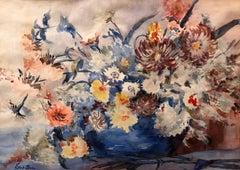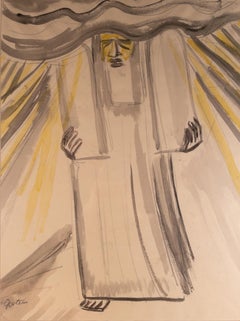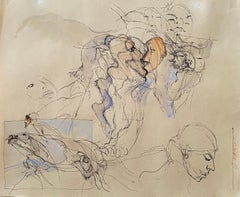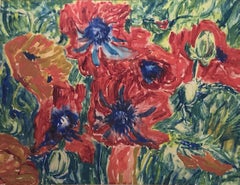Sir Jacob Epstein Drawings and Watercolor Paintings
to
2
1
Overall Width
to
Overall Height
to
3
2
1
2
1
1
1
1
1
1
1
3
3
2
1
5
971
401
330
279
2
1
2
1
Artist: Sir Jacob Epstein
British Modernist Vibrant Watercolor Painting of Flowers, Sir Jacob Epstein
By Sir Jacob Epstein
Located in Surfside, FL
Sir Jacob Epstein KBE (10 November 1880 – 19 August 1959) was an American British sculptor who helped pioneer modern sculpture. He was born in the United States, and moved to Europe in 1902, becoming a British subject in 1911. He often produced controversial works which challenged ideas on what was appropriate subject matter for public artworks. He also made paintings and drawings, and often exhibited his work.
Epstein's parents were Polish Jewish refugees, living on New York's Lower East Side. He studied art in his native New York as a teenager, sketching the city, and joined the Art Students League of New York in 1900. For his livelihood, he worked in a bronze foundry by day, studying drawing and sculptural modelling at night. Epstein's first major commission was to illustrate Hutchins Hapgood's 1902 book Spirit of the Ghetto. Epstein used the money from the commission to move to Paris.
Moving to Europe in 1902, he studied in Paris at the Académie Julian and the École des Beaux-Arts. He settled in London in 1905 and married Margaret Dunlop in 1906. Epstein became a British subject on 4 January 1911. Many of Epstein's works were sculpted at his two cottages in Loughton, Essex, where he lived first at number 49 then 50, Baldwin's Hill (there is a blue plaque on number 50). He served briefly in the 38th Battalion of the Royal Fusiliers, known as the Jewish Legion during World War I; following a breakdown, he was discharged in 1918 without having left England.
In London, Epstein involved himself with a bohemian and artistic crowd. Revolting against ornate, pretty art, he made bold, often harsh and massive forms of bronze or stone. His sculpture is distinguished by its vigorous rough-hewn realism. Avant-garde in concept and style, his works often shocked his audience. This was not only a result of their (often explicit) sexual content, but also because they deliberately abandoned the conventions of classical Greek sculpture favoured by European Academic sculptors to experiment instead with the aesthetics of art traditions as diverse as those of India, West Africa, and the Pacific Islands.
Between 1913 and 1915, Epstein was associated with the short-lived Vorticism movement and produced one of his best known sculptures The Rock Drill.
Between the late 1930s and the mid-1950s, numerous works by Epstein were exhibited in Blackpool. Adam, Consummatum Est, Jacob and the Angel and Genesis, and other works, were initially displayed in an old drapery shop surrounded by red velvet curtains. The crowds were ushered in at the cost of a shilling by a barker on the street. After a small tour of American fun fairs, the works were returned to Blackpool and were exhibited in the anatomical curiosities section of Louis Tussaud's waxworks.
Bronze portrait sculpture formed one of Epstein's staple products, and perhaps the best known. These sculptures were often executed with roughly textured surfaces, expressively manipulating small surface planes and facial details. Some fine examples are in the National Portrait Gallery. He completed a bust of Winston Churchill...
Category
1930s Modern Sir Jacob Epstein Drawings and Watercolor Paintings
Materials
Paper, Watercolor
Dahlias
By Sir Jacob Epstein
Located in Douglas, Isle of Man
Sir Jacob Epstein K.B.E. 1880-1959, was an American born English sculptor, who pioneered modern sculpture. He had a very long and productive career and was considered the greatest s...
Category
1930s Sir Jacob Epstein Drawings and Watercolor Paintings
Materials
Paper, Watercolor
Moses With the Ten Commandments
By Sir Jacob Epstein
Located in New York, NY
Moses With the Ten Commandments by Sir Jacob Epstein (1880-1959)
Pencil and watercolor on paper
22 x 16 ⅝ inches unframed (55.88 x 42.24 cm)
28 ½ x 23 inches framed (72.39 x 58.42 cm)
Signed on bottom left
Description:
In this figurative watercolor painting, Jacob Epstein depicts Moses holding two tablets, one in each arm, that are inscribed with the ten commandments. This is a visualization of the traditional biblical story in which Moses goes to Mount Sinai and has the ten commandments revealed to him by God which he inscribed onto two tablets and keeps in the Ark of the Covenant...
Category
20th Century Post-Modern Sir Jacob Epstein Drawings and Watercolor Paintings
Materials
Watercolor, Pencil
Related Items
“Animals and Figures”
Located in Southampton, NY
Original pen and black ink drawing with watercolor wash in specific areas. Study of figures and animals intertwined. Signed vertically right side along with the artist’s initials lower right. The artwork is tabbed on top two corners to a heavy card backing. Circa 1965. Condition is good to very good. Under UV plexiglass. Framed in a contemporary silver gallery frame. Overall framed measurements are 16.5 by 19 inches. Provenance: A Sarasota, Florida estate.
Craig Rubadoux...
Category
1960s Post-Modern Sir Jacob Epstein Drawings and Watercolor Paintings
Materials
Paper, Ink, Watercolor, Pen
The Terrace
By Maurice Savin
Located in London, GB
'The Terrace', watercolour on art paper, by Maurice Savin (circa 1950s). An inviting scene from the South of France depicts a quiet sun terrace on a balmy day with azure skies. The v...
Category
1950s Modern Sir Jacob Epstein Drawings and Watercolor Paintings
Materials
Paper, Watercolor
Botanical Studies, Watercolours on Silk on Handmade Paper, Set of Three Tulips.
By La Roche Laffitte
Located in Cotignac, FR
A set of three fine hand painted botanical watercolour studies on silk of tulips by La Roche Laffitte. The works are signed bottom right. Some are titled and numbered (see photos) Th...
Category
Late 20th Century Sir Jacob Epstein Drawings and Watercolor Paintings
Materials
Silk, Watercolor, Handmade Paper, Gouache
$1,354 Sale Price
20% Off
H 21.19 in W 15.16 in D 0.04 in
Botanical Cyanotype, Blue Flower Bouquet, Large Wild Roses Cyanotype, Watercolor
By Kind of Cyan
Located in Barcelona, ES
This is an exclusive handprinted limited edition cyanotype of a gorgeous blue bouquet.
Details:
+ Title: Blue Flower Bouquet
+ Year: 2024
+ Edition Size: 100
+ Medium: Acrylic Pain...
Category
2010s Baroque Sir Jacob Epstein Drawings and Watercolor Paintings
Materials
Emulsion, Watercolor, Photographic Paper, Monoprint, Monotype
Botanical Studies, Pair of Watercolours on Silk on Handmade Paper, Anemones
Located in Cotignac, FR
A pair of fine hand painted botanical watercolour studies on silk of anemones by La Roche Laffitte. The works are signed bottom right. Both are titled. The silk has been mounted on h...
Category
Late 20th Century Sir Jacob Epstein Drawings and Watercolor Paintings
Materials
Silk, Watercolor, Handmade Paper, Gouache
$977
H 21.26 in W 15.56 in D 0.04 in
French Impressionist Tablescape Still Life Watercolour
Located in Cotignac, FR
French Impressionist watercolour on paper view of a colourful tablescape still life by Henri Clamen. The painting is not signed but was acquired form the atelier of the artist with o...
Category
Early 20th Century Impressionist Sir Jacob Epstein Drawings and Watercolor Paintings
Materials
Paper, Ink, Watercolor
Original 70's Hand Painted Textile Design Gouache Navy Blue Color on White Paper
Located in ALCOY/ALCOI, ES
Compass Rose and Flower design. Sealed on the back with the design studio name and number 397
We offer a small number of these original illustration designs by this design studio ba...
Category
1970s Modern Sir Jacob Epstein Drawings and Watercolor Paintings
Materials
Paper, Gouache
$1,013
H 34.65 in W 18.9 in D 0.12 in
A Stunning ca. 1950s Cubist Watercolor of Irises by Rita Duis (Astley-Bell)
Located in Chicago, IL
A stunning Cubist watercolor on paper of purple irises by Chicago and New York artist Rita Duis (Astley-Bell). Archivally matted to30" x 24".
Artist Rita Duis (Astley-Bell) led an ...
Category
1950s American Modern Sir Jacob Epstein Drawings and Watercolor Paintings
Materials
Watercolor, Paper
$575 Sale Price
52% Off
H 30 in W 24 in
Sea Shells – Blue & Gold
By Zama Vanessa Helder
Located in Los Angeles, CA
Sea Shells – Blue & Gold, c. 1940s, watercolor on paper, signed upper left, 15 x 19 ¼ inches (image); title and artist’s name and address inscribed verso, presented in a newer glazed...
Category
1940s American Modern Sir Jacob Epstein Drawings and Watercolor Paintings
Materials
Paper, Watercolor
Israeli Judaica Original Painting King David and Angel Polish Artist Arie Dubi
Located in Surfside, FL
Dubi Arie (born Poland, 1939)
"A Song in the Garden"
Original mixed media on paper painting,
Hand signed and dated lower left.
This piece depicts people dancing, including a King ...
Category
20th Century Post-Modern Sir Jacob Epstein Drawings and Watercolor Paintings
Materials
Paper, Oil Crayon, Mixed Media, Watercolor
Mid Century Italian Tablescape With Red Cloth, 1956, Circle of Giorgio Morandi
By Giorgio Morandi
Located in Cotignac, FR
Mid Century Italian watercolour on paper of a tablescape, signed and dated (1956) bottom right. The artist is currently unknown.
Presented under glass in original, period plain woo...
Category
Mid-20th Century Expressionist Sir Jacob Epstein Drawings and Watercolor Paintings
Materials
Paper, Ink, Watercolor
$691
H 28 in W 20 in D 1 in
"Dahlias" Chiura Obata, Japanese American, Red and Blue Delicate Floral Work
By Chiura Obata
Located in New York, NY
Chiura Obata
Dahlias, 1940
Signed, dated and stamped lower right
Watercolor on paper
15 x 9 5/8 inches
Born in the Okayama prefecture of Japan, Chiura Obata was adopted by his uncle, an artist. As a child he was trained in ink painting, and at 14 he was apprenticed to the painter Murata Tanryo in Tokyo. He also studied with Kogyo Terasaki and Goho Hasimoto.
In 1903, Obata moved to San Francisco and began working as an illustrator for The New World and The Japanese American, two of the city's Japanese newspapers. He also did work as a commercial designer. Obata helped establish the East West Art Society in San Francisco in 1921, which sought to promote cross-cultural understanding through art. This goal was reflected in his embrace of the Nihonga style, which fused traditional Japanese sumi-e ink painting with the conventions of western naturalism.
He spent much of the 1920s painting landscapes throughout California, and among his favorite subjects were mountain landscapes. In 1927, he visited Yosemite and the Sierra Nevada, creating over a hundred paintings and sketches of the high country. Obata stayed in the USA until the death of his father in 1928.
Between 1928 and 1932, he worked in Tokyo as a painter and transformed his California landscape watercolors...
Category
1940s Modern Sir Jacob Epstein Drawings and Watercolor Paintings
Materials
Paper, Watercolor
$4,500
H 22.5 in W 16.5 in
Previously Available Items
Sir Jacob Epstein, Still life of Poppies, Jewish Modernist artist
By Sir Jacob Epstein
Located in Harkstead, GB
Sir Jacob Epstein (1880-1959)
Poppies,
Signed,
Watercolour and touches of gouache,
17 x 22 inches
Exhibited: Arthur Tooth and Sons, 1936 (Gallery label verso)
Provenance: Private...
Category
Early 20th Century Impressionist Sir Jacob Epstein Drawings and Watercolor Paintings
Materials
Watercolor, Gouache, Paper
British Modernist Vibrant Watercolor Painting of Flowers
By Sir Jacob Epstein
Located in Surfside, FL
Sir Jacob Epstein KBE (10 November 1880 – 19 August 1959) was an American British sculptor who helped pioneer modern sculpture. He was born in the United States, and moved to Europe in 1902, becoming a British subject in 1911. He often produced controversial works which challenged ideas on what was appropriate subject matter for public artworks. He also made paintings and drawings, and often exhibited his work.
Epstein's parents were Polish Jewish refugees, living on New York's Lower East Side. He studied art in his native New York as a teenager, sketching the city, and joined the Art Students League of New York in 1900. For his livelihood, he worked in a bronze foundry by day, studying drawing and sculptural modelling at night. Epstein's first major commission was to illustrate Hutchins Hapgood's 1902 book Spirit of the Ghetto. Epstein used the money from the commission to move to Paris.
Moving to Europe in 1902, he studied in Paris at the Académie Julian and the École des Beaux-Arts. He settled in London in 1905 and married Margaret Dunlop in 1906. Epstein became a British subject on 4 January 1911. Many of Epstein's works were sculpted at his two cottages in Loughton, Essex, where he lived first at number 49 then 50, Baldwin's Hill (there is a blue plaque on number 50). He served briefly in the 38th Battalion of the Royal Fusiliers, known as the Jewish Legion during World War I; following a breakdown, he was discharged in 1918 without having left England.
In London, Epstein involved himself with a bohemian and artistic crowd. Revolting against ornate, pretty art, he made bold, often harsh and massive forms of bronze or stone. His sculpture is distinguished by its vigorous rough-hewn realism. Avant-garde in concept and style, his works often shocked his audience. This was not only a result of their (often explicit) sexual content, but also because they deliberately abandoned the conventions of classical Greek sculpture favoured by European Academic sculptors to experiment instead with the aesthetics of art traditions as diverse as those of India, West Africa, and the Pacific Islands.
Between 1913 and 1915, Epstein was associated with the short-lived Vorticism movement and produced one of his best known sculptures The Rock Drill.
Between the late 1930s and the mid-1950s, numerous works by Epstein were exhibited in Blackpool. Adam, Consummatum Est, Jacob and the Angel and Genesis, and other works, were initially displayed in an old drapery shop surrounded by red velvet curtains. The crowds were ushered in at the cost of a shilling by a barker on the street. After a small tour of American fun fairs, the works were returned to Blackpool and were exhibited in the anatomical curiosities section of Louis Tussaud's waxworks.
Bronze portrait sculpture formed one of Epstein's staple products, and perhaps the best known. These sculptures were often executed with roughly textured surfaces, expressively manipulating small surface planes and facial details. Some fine examples are in the National Portrait Gallery. He completed a bust of Winston Churchill...
Category
1930s Modern Sir Jacob Epstein Drawings and Watercolor Paintings
Materials
Paper, Watercolor
Sunita
By Sir Jacob Epstein
Located in Petworth, West Sussex
Sir Jacob Epstein (British/American 1880-1959)
Sunita
Pencil and watercolour on paper
Signed `Epstein’ (lower left)
11.1/4 x 9.1/2 in. (28.6 x 24.2 cm.)
Provenance Christie’s Londo...
Category
Early 20th Century Modern Sir Jacob Epstein Drawings and Watercolor Paintings
Materials
Paper, Watercolor, Pencil
Sir Jacob Epstein drawings and watercolor paintings for sale on 1stDibs.
Find a wide variety of authentic Sir Jacob Epstein drawings and watercolor paintings available for sale on 1stDibs. You can also browse by medium to find art by Sir Jacob Epstein in paint, watercolor, paper and more. Much of the original work by this artist or collective was created during the 20th century and is mostly associated with the modern style. Not every interior allows for large Sir Jacob Epstein drawings and watercolor paintings, so small editions measuring 17 inches across are available. Customers who are interested in this artist might also find the work of Reginald Marsh, Jean Dufy, and Jacques Villon. Sir Jacob Epstein drawings and watercolor paintings prices can differ depending upon medium, time period and other attributes. On 1stDibs, the price for these items starts at $3,000 and tops out at $45,000, while the average work can sell for $24,000.





